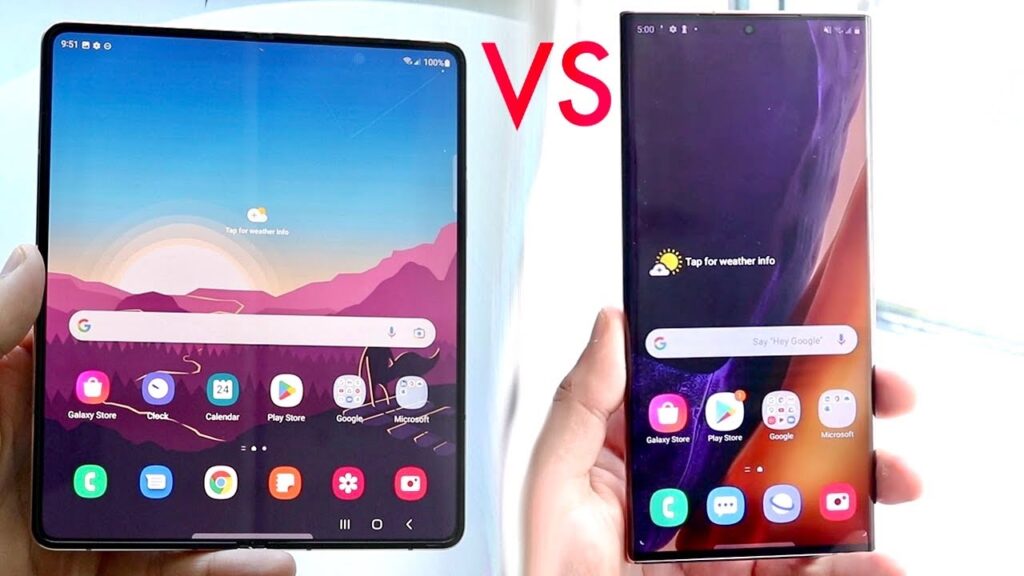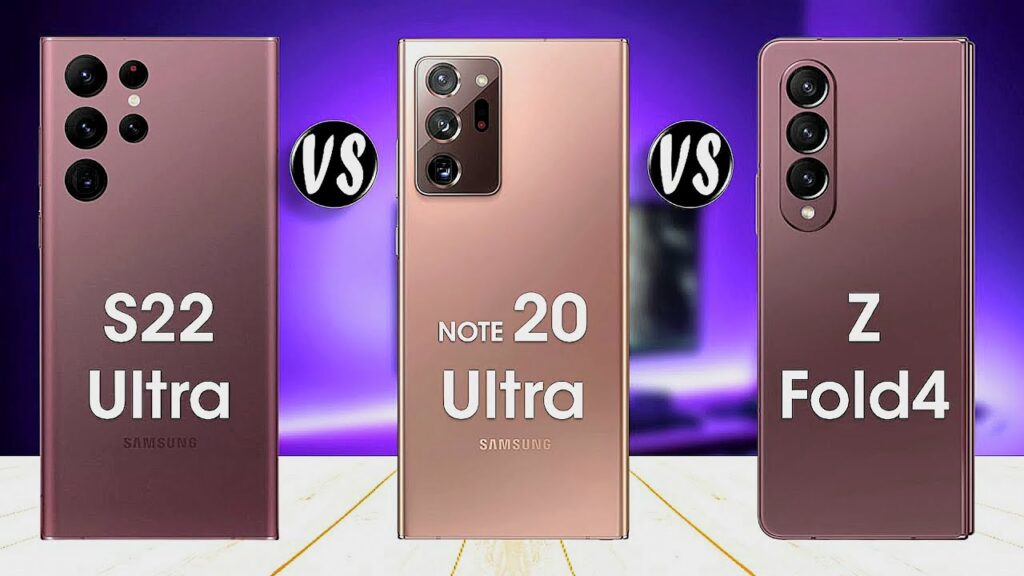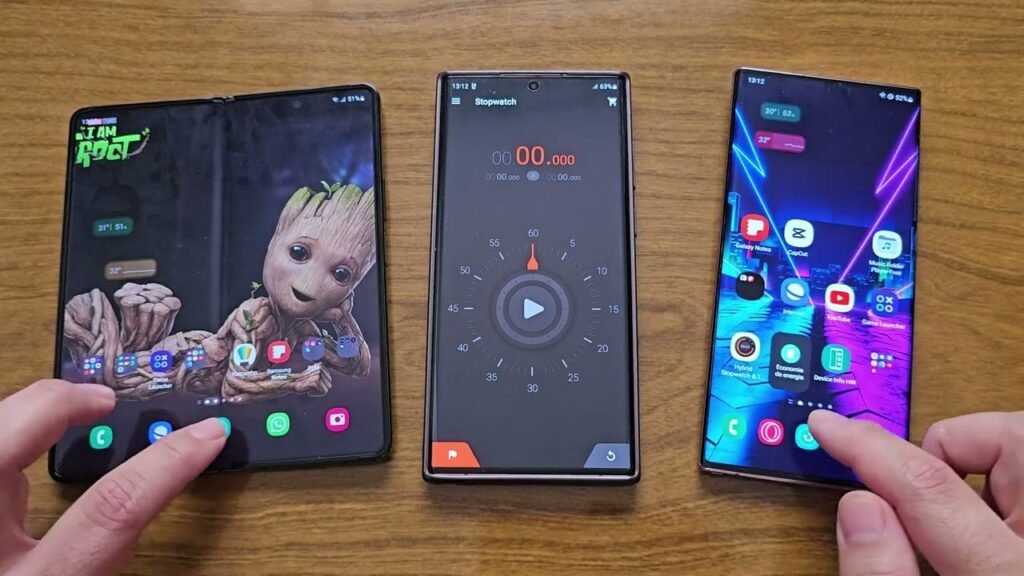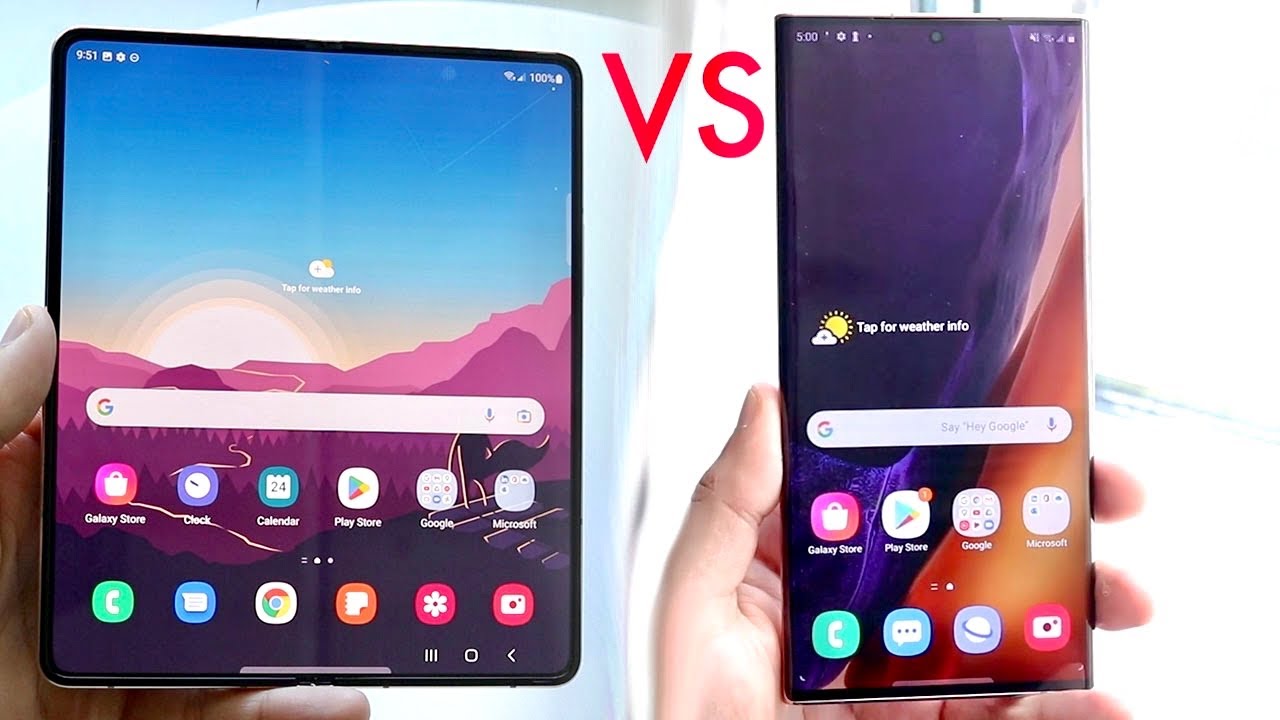In this article, I will be comparing two powerhouse smartphones from Samsung: the Samsung Galaxy Note 20 Ultra and the Samsung Galaxy Z Fold 4. Both these devices offer cutting-edge features and impressive specifications. From the stunning display to the powerful processors, we will explore how these devices stack up against each other and help you make an informed decision on which one is right for you. So, let’s dive in and see what these devices have to offer!
Design
Overall design
When it comes to design, both the Samsung Galaxy Note 20 Ultra and the Samsung Galaxy Z Fold 4 offer sleek and stylish aesthetics. The Note 20 Ultra features a traditional candy bar design, with a slim profile and elegant curves. The Z Fold 4, on the other hand, takes a bold and innovative approach with its foldable design, allowing users to enjoy the functionality of both a smartphone and a tablet in one device.
Display size and type
The display size is where the two devices differ significantly. The Galaxy Note 20 Ultra boasts a large 6.9-inch Dynamic AMOLED display, providing users with ample screen real estate for productivity and media consumption. On the other hand, the Galaxy Z Fold 4 takes things to the next level with its 7.6-inch foldable Dynamic AMOLED display, offering a truly immersive experience.
Form factor
In terms of form factor, the Galaxy Note 20 Ultra has a more traditional candy bar design, making it more compact and easier to handle with one hand. The Galaxy Z Fold 4, with its foldable design, may be bulkier when folded, but it offers the advantage of being able to unfold into a larger tablet-like form factor, giving users a more expansive display for multitasking and content creation.
Build quality
Both the Galaxy Note 20 Ultra and the Galaxy Z Fold 4 are built to high standards, showcasing Samsung’s commitment to quality. The Note 20 Ultra features a combination of glass and metal, giving it a premium and sturdy feel in the hand. The Z Fold 4, being a foldable device, incorporates a hinge mechanism that allows for easy folding and unfolding, while maintaining a solid and durable build. Overall, both devices exude a sense of robustness and attention to detail in their construction.
Camera
Rear camera setup
The camera setups on both the Samsung Galaxy Note 20 Ultra and the Samsung Galaxy Z Fold 4 are highly impressive. The Note 20 Ultra sports a triple-camera setup, consisting of a 108-megapixel wide-angle lens, a 12-megapixel ultra-wide-angle lens, and a 12-megapixel telephoto lens. This versatile setup allows users to capture stunning photos with incredible detail and clarity, regardless of the shooting scenario.
The Z Fold 4, on the other hand, also features a triple-camera setup, with similar specifications to the Note 20 Ultra. This ensures that users can enjoy the same exceptional photographic capabilities, whether they are using their device in its folded or unfolded form.
Front camera setup
In terms of the front camera setup, both devices offer high-resolution selfie cameras that are more than capable of capturing great self-portraits and conducting video calls. The Galaxy Note 20 Ultra features a 10-megapixel front-facing camera, while the Galaxy Z Fold 4 takes it a step further with a dual-camera setup, comprising a 10-megapixel primary sensor and a 4-megapixel depth sensor. This additional depth sensor enables the Z Fold 4 to capture stunning portrait shots with accurate background blur.
Camera features
Both the Note 20 Ultra and the Z Fold 4 are packed with a range of camera features to enhance the photography experience. From Night Mode and Pro Mode to Super Slow-mo, these devices offer various shooting modes and tools to cater to different creative needs. Additionally, both devices support 8K video recording, allowing users to capture high-resolution videos with exceptional detail.
Image and video quality
When it comes to image and video quality, both devices excel in capturing stunning visuals. The Note 20 Ultra’s triple-camera setup maximizes image resolution and clarity, resulting in sharp and vibrant photos. The Z Fold 4, with its similar camera setup, ensures that users can enjoy the same level of image quality, even when using the device in its unfolded tablet-like form. With their advanced image processing algorithms, both devices deliver exceptional image quality that will satisfy even the most discerning photographers and videographers.

This image is property of i.ytimg.com.
Performance
Processor
The Samsung Galaxy Note 20 Ultra and the Samsung Galaxy Z Fold 4 are powered by cutting-edge processors, ensuring smooth and fast performance. The Note 20 Ultra is equipped with either a Qualcomm Snapdragon 865+ or Samsung’s own Exynos 990 chipset, depending on the region. These powerful processors, combined with ample RAM, ensure that the device can handle multitasking, gaming, and demanding applications with ease.
The Z Fold 4 is expected to feature an even more advanced chipset, potentially the Qualcomm Snapdragon 888 or Samsung’s next-generation Exynos chipset. This will provide users with an even higher level of performance, enhancing their overall user experience, whether they are using the device in its folded or unfolded form.
RAM and storage
Both the Note 20 Ultra and the Z Fold 4 come with generous amounts of RAM and storage options to meet the needs of power users. The Note 20 Ultra offers either 12GB or 16GB of RAM, depending on the variant, ensuring smooth multitasking and seamless app switching. In terms of storage, users can choose between 128GB, 256GB, or 512GB, with the option to expand it further using a microSD card.
While the exact specifications for the Z Fold 4 are yet to be confirmed, it is safe to assume that it will offer a similar level of RAM and storage options, if not higher, to ensure optimal performance and ample space for storing files, documents, and media.
Battery capacity
Battery life is a crucial aspect for any smartphone user, and both the Note 20 Ultra and the Z Fold 4 are expected to deliver. The Note 20 Ultra is equipped with a sizable 4,500mAh battery, which provides all-day usage on a single charge, even with heavy usage. The Z Fold 4, being a larger device, is likely to feature an even more substantial battery capacity, ensuring that users can enjoy the benefits of its larger display without having to constantly worry about running out of power.
Software and user interface
Both the Note 20 Ultra and the Z Fold 4 run on Samsung’s One UI, which is a user-friendly and feature-rich interface layered on top of the Android operating system. One UI offers a clean and intuitive user experience, with a range of customization options to tailor the device to individual preferences. Additionally, Samsung is known for its frequent software updates, ensuring that users receive the latest features, enhancements, and security patches to keep their device running smoothly.
Display
Display technology
The displays on both the Samsung Galaxy Note 20 Ultra and the Samsung Galaxy Z Fold 4 are nothing short of impressive. The Note 20 Ultra features a Dynamic AMOLED display, which offers vibrant colors, deep blacks, and excellent viewing angles. This ensures that users can enjoy a truly immersive visual experience when consuming media, playing games, or browsing the web.
The Z Fold 4 takes things to the next level with its innovative foldable Dynamic AMOLED display. This flexible display technology allows the device to unfold into a larger tablet-like form factor, providing users with a more expansive canvas for productivity, multitasking, and content consumption.
Resolution and pixel density
Both devices boast high-resolution displays, ensuring that users can enjoy detailed visuals. The Note 20 Ultra features a Quad HD+ resolution of 3200 x 1440 pixels, resulting in a pixel density of approximately 496 pixels per inch (PPI). This sharp display ensures that every detail is rendered with precision, enhancing the overall viewing experience.
The Z Fold 4, with its larger display, is expected to offer a similar resolution or potentially an even higher resolution to ensure optimal clarity and detail, regardless of whether the device is folded or unfolded.
Screen-to-body ratio
The screen-to-body ratio is an important aspect to consider when evaluating the display quality of a smartphone. The Note 20 Ultra boasts an impressive screen-to-body ratio, with minimal bezels and a small centrally located punch-hole camera. This ensures that users can enjoy a truly immersive experience, with minimal distractions and maximum display real estate.
The Z Fold 4, being a foldable device, is likely to offer an even higher screen-to-body ratio, especially when unfolded. This means that users can expect a truly immersive and uninterrupted viewing experience, with the display covering a significant portion of the device’s front surface.
Refresh rate
The refresh rate of a display determines how smooth and responsive the user interface feels during interactions. The Note 20 Ultra features a high refresh rate of 120Hz, offering silky-smooth scrolling, seamless app switching, and highly responsive touch controls. This enhances the overall user experience, making interactions with the device feel incredibly fluid and snappy.
While the exact specifications for the Z Fold 4’s refresh rate are yet to be confirmed, it is highly likely that Samsung will equip it with a similar or even higher refresh rate to ensure optimal performance and a premium user experience.

This image is property of i.redd.it.
Versatility
Foldable vs non-foldable
The most significant differentiating factor between the Galaxy Note 20 Ultra and the Galaxy Z Fold 4 is the foldable design of the latter. While the Note 20 Ultra offers a traditional candy bar design, the Z Fold 4 offers the versatility of transforming from a smartphone into a tablet-like device by simply unfolding it. This unique feature provides users with the best of both worlds, allowing them to enjoy the portability and convenience of a smartphone, as well as the productivity and immersive experience of a tablet.
Multi-window and multitasking capabilities
Both the Note 20 Ultra and the Z Fold 4 offer robust multi-window and multitasking capabilities, catering to users who require efficient multitasking for work or leisure purposes. The Note 20 Ultra’s large display and powerful processor enable users to run multiple apps simultaneously, easily switch between them, and even resize app windows for a more customized multitasking experience.
The Z Fold 4 takes multitasking to the next level with its unfolded tablet-like form factor. Users can have multiple apps open side by side, similar to a desktop computer, making it ideal for tasks such as productivity, content creation, and even gaming.
S Pen support
One of the standout features of the Galaxy Note series is the S Pen, and the Note 20 Ultra continues this tradition. The device comes with its iconic S Pen, which offers precise and intuitive handwriting recognition, as well as a range of other productivity-enhancing features. Whether it’s taking notes, sketching, or navigating through the user interface, the S Pen adds an extra layer of convenience and creativity to the Note 20 Ultra.
As for the Z Fold 4, it is yet to be confirmed whether it will support the S Pen. However, given its focus on versatility and productivity, it wouldn’t be surprising if Samsung introduces S Pen support for the foldable device, allowing users to take full advantage of its larger display for note-taking and creative tasks.
Security
Biometric authentication
Both the Samsung Galaxy Note 20 Ultra and the Samsung Galaxy Z Fold 4 offer advanced biometric authentication options to ensure the security and privacy of user data. The Note 20 Ultra features an ultrasonic fingerprint sensor embedded beneath the display, allowing users to unlock their device quickly and securely by simply placing their finger on the designated area of the screen.
The Z Fold 4 is expected to offer a similar or potentially even more advanced biometric authentication system, potentially incorporating an under-display fingerprint sensor as well as facial recognition technology. These features offer users multiple options to choose from, based on their personal preference and convenience.
Security features
In addition to biometric authentication, both devices offer a range of other security features to safeguard user data. These include secure folder functionality, which allows users to store sensitive files and documents in a separate, encrypted space on the device. Both devices also come with Samsung Knox, a comprehensive security platform that protects against malware, unauthorized access, and other cyber threats.
Privacy options
Privacy is a top concern for many users, and Samsung has taken this into account with its devices. Both the Note 20 Ultra and the Z Fold 4 offer a range of privacy options, allowing users to customize the level of access apps have to their personal data. This includes permissions management, privacy settings, and the ability to control app permissions for features such as location access, camera usage, and more.

This image is property of i.ytimg.com.
Connectivity
5G capabilities
The Samsung Galaxy Note 20 Ultra and the Samsung Galaxy Z Fold 4 are both 5G-capable devices, ensuring that users can take advantage of the next-generation network speeds and connectivity. With 5G, users can experience faster download and upload speeds, lower latency, and more reliable connections, enhancing their overall mobile experience.
Wi-Fi
Both devices support the latest Wi-Fi standards, including Wi-Fi 6, ensuring fast and reliable wireless internet connectivity. Wi-Fi 6 offers improved speeds, lower latency, and better performance in crowded areas, making it ideal for activities such as streaming high-quality content, online gaming, and video conferencing.
Bluetooth
Bluetooth connectivity is a crucial aspect for any smartphone user, as it allows for wireless pairing with a range of devices such as headphones, speakers, and smartwatches. Both the Note 20 Ultra and the Z Fold 4 come with Bluetooth 5.1, providing users with reliable and energy-efficient Bluetooth connectivity for seamless and convenient wireless audio and data transfer.
NFC
Near Field Communication (NFC) is a technology that enables contactless communication and allows devices to interact with each other by simply being in close proximity. Both devices are equipped with NFC, providing users with the convenience of making contactless payments, transferring files, and connecting to compatible devices with a simple tap.
Software
Operating system
Both the Samsung Galaxy Note 20 Ultra and the Samsung Galaxy Z Fold 4 run on the Android operating system. The Note 20 Ultra initially launched with Android 10 but is eligible for an upgrade to the latest Android version, ensuring that users can enjoy the latest features and enhancements offered by Google.
As for the Z Fold 4, it is expected to launch with the latest version of Android, ensuring that users have access to the most current features and improvements from the outset.
Custom UI
Samsung’s custom user interface, One UI, is layered on top of the Android operating system, offering a distinct and user-friendly interface. One UI provides a range of customization options, allowing users to tailor their device to their individual preferences. The interface is designed to simplify navigation, enhance productivity, and optimize the overall user experience.
Software updates
Samsung has a commendable track record when it comes to software updates, ensuring that users receive regular updates to their devices. This includes not only security patches and bug fixes but also major operating system upgrades. With their flagship devices like the Note 20 Ultra and the Z Fold 4, users can expect to receive timely updates that not only enhance security but also introduce new features and improvements to their devices.

This image is property of i.ytimg.com.
Price
Expected price point
The pricing of the Samsung Galaxy Note 20 Ultra and the Samsung Galaxy Z Fold 4 will depend on various factors, including regional variations, storage options, and any bundle offerings. The Note 20 Ultra was launched with a starting price of around $1,299, and it is expected that the Z Fold 4 will fall within a similar price range given its advanced features and foldable design.
Value for money
Both the Note 20 Ultra and the Z Fold 4 offer exceptional value for money, given their premium build quality, advanced features, and cutting-edge technologies. While their price points may be on the higher end of the spectrum, the benefits and capabilities they bring to users justify the investment. Whether it’s the versatility of the Z Fold 4’s foldable display or the productivity-enhancing features of the Note 20 Ultra, these devices offer a unique and immersive experience that is well worth the price for those who prioritize performance and innovation.
Conclusion
Overall comparison
In conclusion, both the Samsung Galaxy Note 20 Ultra and the Samsung Galaxy Z Fold 4 are impressive devices that cater to different user preferences and requirements. The Note 20 Ultra offers a traditional candy bar design with a large display, exceptional camera capabilities, and powerful performance, making it an ideal choice for users who prioritize productivity, media consumption, and photography.
On the other hand, the Z Fold 4 takes a bold leap into the future with its foldable design, offering users the flexibility of using their device as both a smartphone and a tablet. With its larger unfolded display, impressive camera features, and advanced multitasking capabilities, the Z Fold 4 is perfect for users who require a more immersive and versatile experience that goes beyond the capabilities of a traditional smartphone.
Target audience preferences
The target audience for the Note 20 Ultra includes professionals, creatives, and power users who demand top-tier performance, enhanced productivity tools, and a best-in-class camera system. The device’s sleek design, powerful processor, and S Pen support make it particularly appealing to those who require a device that can keep up with their demanding workloads and creative endeavors.
The Z Fold 4, with its foldable design and expansive display, caters to users who value versatility, multitasking, and cutting-edge innovation. Business professionals, content creators, and those who prioritize productivity on the go will find the Z Fold 4 to be a game-changing device, enabling them to work, create, and consume content in ways that weren’t possible before.
Final verdict
Both the Samsung Galaxy Note 20 Ultra and the Samsung Galaxy Z Fold 4 offer impressive features, advanced technologies, and a premium user experience. Choosing between the two ultimately comes down to personal preferences and priorities.
If you are seeking a traditional smartphone experience with exceptional performance, camera capabilities, and S Pen support for enhanced productivity, the Note 20 Ultra is the ideal choice. On the other hand, if you crave a more versatile and immersive experience, with the ability to seamlessly transition between smartphone and tablet-like functionality, the Z Fold 4 is the device for you.
Whichever device you choose, both the Note 20 Ultra and the Z Fold 4 showcase Samsung’s commitment to pushing the boundaries of technology and delivering devices that are designed for the needs of the modern user.

This image is property of i.ytimg.com.


